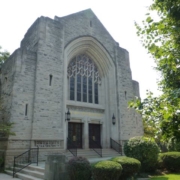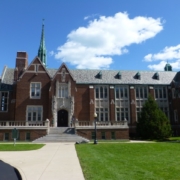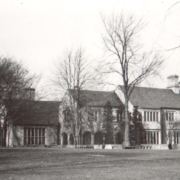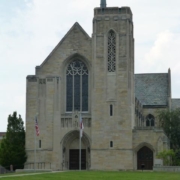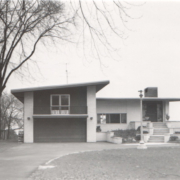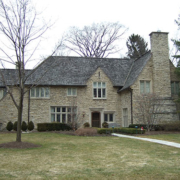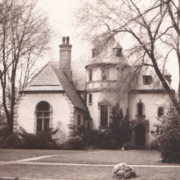Historical Architecture of Grosse Pointe – The Church That Grew and Grew – Grosse Pointe Memorial Church
Three buildings, two sites, ten names and thirteen full-time ministers Grosse Pointe Memorial Church has been pretty busy since its first building was completed in 1867.
The Memorial Church is a wonderful example of how Grosse Pointe has changed and evolved over the years. Grosse Pointe is filled with many wonderful churches. Each one has exceptional architectural content, is steeped in history, play’s an integral part of the community, and are constantly growing, blooming and evolving.

The present membership of the Memorial Church is around 1250 people, nearly as many people as the entire population of Grosse Pointe in 1865.
Lets start from the beginning. Back in 1865 a group of Grosse Pointe residents founded the Grosse Pointe Protestant Church. During this time the area was becoming a popular destination as a summer resort for Detroit businessmen and their families, building summer cottages along Lake St Clair. The sudden influx of people to the area meant the congregation began to grown.
To accommodate the increasing numbers, in 1867 the group of residents decided to build their first church building. The original tiny white frame church, known as the Little White Grosse Pointe Memorial Church, stood on the southwest corner of today’s intersection of Kerby and Lake Shore Roads. By 1881, when Grosse Pointers were beginning to build year round homes, membership had grown to require an addition to the original building and the church had enough members to warrant holding service’s during the winter as well as the summer.
For the visiting ministers from Detroit who served the church, holding services on Sunday afternoons, meant they had to make a five-hour trip on horse back each week. The road to Grosse Pointe could be pretty treacherous during the winter season and was regularly ankle deep in mud or covered in snow.
By 1890 there were sufficient members to warrant a full-time minister. The church adopted its fourth name – the Grosse Pointe Protestant Church – however many people still referred to it as the Little White Church.
In 1894, the Church moved to a new site on land donated by prominent Grosse Pointer Joseph H. Berry. The new building, located at its current site – 16 Lake Shore, quickly became know as the Little Ivy Covered Church, or just the Ivy Covered Church (its fifth and sixth names). The structure seated around 200 people, and was also used as a center for community, social and cultural events.
During 1910 and 1920 the population of Grosse Pointe doubled. The automobile industry was in full swing and Grosse Pointe was becoming a haven for wealthy families looking to relocate to the suburbs. As the residential scene of Grosse Pointe was undergoing a dramatic transformation, so too was the development of churches within the community.
By now the Ivy Covered Church was known as the Grosse Pointe Presbyterian Church and the building was bursting at the seams. It is reported Truman H. Newberry and his brother John donated nearly $300,000 to the congregation to pay for a new building as a memorial to their parents. There was however one requirement – the name of the church had to be changed to the Grosse Pointe Memorial Church.
The new Grosse Pointe Memorial Church was designed by Ontario born architect W. E. N. Hunter. He was known throughout the Midwest as the “church architect”, he worked out of Detroit between 1899 and 1939.
The Gothic Revival structure was constructed between 1923 and 1927, consisting of the church itself and four additional units. The church structure is an asymmetrically design with a cross gable roof and a bell tower. It is constructed of limestone, trimmed with smooth sandstone, featuring many stained glass windows and a slate roof. The front façade is topped with a front gable, while each side elevation features four bays with pairs of stained glass clerestory windows.
The central nave is laid out in the form of a Latin Crosse with a vaulted ceiling. The aisles are separated from the nave by masonry pillars, while arched entryways are present on each side of the church.
The Willet Stained Glass Company of Philadelphia, who also worked on several windows in Christ Church, designed the majority of the stained glass windows, while German Master woodcarver Alois Lang created the fabulous carvings. Lang has been described as one of the artists responsible for bringing medieval art of ecclesiastical carving to the United States, and he worked on many churches in the Metro Detroit area.
The exterior and the interior of the church incorporate several recurring symbols into its design. On the exterior over 40 shields decorate the entrance, around the bell tower and also in various parts of the interior. Another recurring symbol are the vines and the branches, which are present in many of the woodcarvings, in the plaster, stone and on the wrought iron.
The majority of the works of art that are found inside the church today have been presented as memorials, including sculptures, paintings, the organ, the forty-seven carillon bells, individual stained glass windows, Pewabic tiles on the sanctuary floor, oriental rugs and the wonderful front doors which depict the Quest for the Holy Grail in four stained glass panels. A large leather bound Memorial Book, kept in the church’s library, is said to record the names of the donors of each gift.
It should also be noted that a piece of wood from the original ivy Covered Church was placed in the cornerstone of the new building in 1927.
The Grosse Pointe Memorial Church has had a rich history and continues to grow to this day, having undergone a major renovation project in 1997. It was listed as a designated Michigan Historical site in 1990 and listed on the National Register of Historic Places in 1993.
Hopefully it won’t be changing its name again anytime soon.
Written by Katie Doelle
© 2015 Katie Doelle
Research from Grosse Pointe Heritage Magazine, courtesy of Grosse Pointe Public Library Local History Archives.

